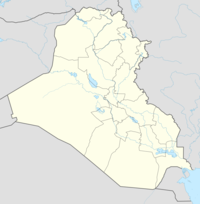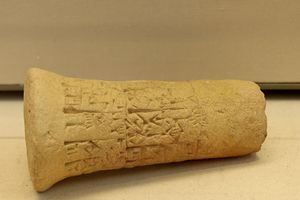باد-تيبيرا
31°22′58″N 46°00′16″E / 31.38278°N 46.00444°E
باد-تيبيرا | |
|---|---|
| الإحداثيات: 31°46′00″N 46°00′00″E / 31.76667°N 46.00000°E |
باد-تيبيرا Bad-tibira، "سور عمال النحاس"،[1] أو "حصن الصنايعية"،[2] تُعرف في العصر الحديث بإسم تل المدينة، بين الشطرة وتل سنكرة (لارسا القديمة) في جنوب العراق،[3] كانت مدينة سومرية قديمة، يظهر اسمها ضمن مدن ما قبل الطوفان في قائمة الملوك السومريين. اسمها الأكادي كان دور-گورگورّي.[4] كما كانت تُسمى Παντιβίβλος (پانتيبيبلوس) من المؤلفين اليونانيين أمثال أبيدنوس Abydenus، أپولودوروس من أثينا Apollodorus و بروسوس Berossus. وقد يعكس هذا نسخة أخرى من اسم المدينة، پاتيبيرا Patibira، "قناة الصنايعية".[5] وقد يكون لهم علاقة بقبيلة تيبارِني Tibareni القرتڤلية Kartvelian القديمة. تيبارِني Tibareni هم أحد القبائل القرتڤلية التي كانت تشغـِّل المعادن منذ وقت مبكر، وقد وصلوا رسمياً إلى البحر المتوسط وأقاموا مملكة تبل الحيثية الجديدة.
التاريخ
وحسب قائمة الملوك السومريين، فإن باد-تيبيرا كانت ثاني مدينة "تمارس الملـَكية" في سومر بعد الطوفان، بعد إريدو. أولئك الملوك قيل أنهم: إن-من-لو-أنا، إن-من-گال-أنا و دوموزيد الراعي.
النص السومري المبكر إنانـّا تنزل إلى العالم السفلي يذكر معبد المدينة، E-mush-kalamma. In this tale، Inanna dissuades demons from the netherworld from taking لولال، patron of Bad-tibira، who was living in squalor. They eventually take Dumuzid، who lived in palatial opulence at أوروك. This Dumuzid is called "the Shepherd",[6] who on the King List resides at Bad-Tibira in contrast to the post-diluvian دوموزيد، الصياد، الذي حكم في أوروك.
The "brotherhood text" in cuneiform inscriptions on cones plundered from the site in the 1930s records the friendship pact of إنتمنا، حاكم لگش، and Lugal-kinishedudu، governor of Uruk. It identifies Entemena as the builder of the temple E-mush[7] to Inanna and Dumuzid، under his local epithet Lugal-E-mush.[8]
الآثار
Some badly effaced half-bricks on the surface of the mound bore the inscription of Amar-Sin، of the Third Dynasty of Ur. Pieces of vitrified brick scattered over the surface of the large mound bore witness to the city's destruction by fire.[9] Possession of the city passed between لارسا، whose king Sin-Iddinam claims to بنى السور العظيم لباد-تيبيرا، وإيسين، التي زعم ملكها ليپيت-عشتار، "راعي نيپور"، أنه شيّد "بيت الحق" هناك.[10]
انظر أيضاً
الهامش
- ^ W.F. Albright and T.O. Lambdin، "The Evidence of Language"، في The Cambridge Ancient History I، part 1 (Cambridge University Press)، 1971، ISBN 0-521-07051-1، page 150.
- ^ Hallo، William W. and William Kelly Simpson، The Ancient Near East: A History، Harcourt Brace Jovanovich، Inc.، New York، 1971، p. 32
- ^ Vaughn E. Crawford، "The Location of Bad-Tibira"، Iraq 22 "Ur in Retrospect. In Memory of Sir C. Leonard Woolley" (Spring - Autumn 1960:197-199); the secure identification is based on the recovery at the pillaged site of fragments of a known inscription of Entemena that had surfaced في السوق السوداء بدون provenance. الحفريات المبكرة في ربوة تسمى "مدائن" بالقرب من موقع لگش، following a report of a vendor of one of the inscriptions، had proved fruitless: see H. de Genouillac، Fouilles de Telloh، ii:139 (noted by Crawford 1960:197 note 7).
- ^ جباية الضرائب من دور-گورگورّي تظهر في أحد مراسلات حمورابي (النصف الأول من القرن 18 ق.م.) مذكورة في L. W. King and H. R. Hall، Egypt and Western Asia in the Light of Recent Discoveries (New York، 2005) p. 306f؛ وقد ظلت مدينة صنائع شغل المعادن ومستوطنة رئيسية لحرفة گورگورّى، "عمال شغل المعادن" (L. W. King، The Letters And Inscriptions Of Hammurabi، King Of Babylon About B.C. 2200 vol. III، p. 21، note 2.).
- ^ Hallo، William W. and William Kelly Simpson، The Ancient Near East: A History، Harcourt Brace Jovanovich، Inc.، New York، 1971، p. 32
- ^ Inanna's descent to the netherworld - ETCSL
- ^ Presumably the same temple as E-mush-kalamma، according to Crawford.
- ^ Crawford 1960:197.
- ^ Crawford 1960:198.
- ^ Ferris J. Stephens، "A Newly Discovered Inscription of Libit-Ishtar" Journal of the American Oriental Society 52.2 (June 1932):182-185) p. 183.
للاستزادة
- W.F. Leemans، Tablets from Bad-tibira and Samsuiluna's Reconquest of the South، JEOL، vol. 15، pp. 214–218، 1957/58

